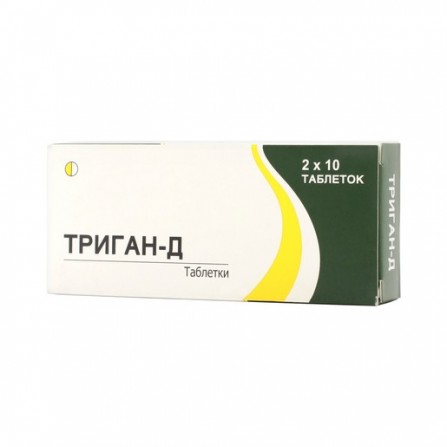Trigan D pills of 20 pieces
Condition: New product
999 Items
Rating:
Be the first to write a review!

More info
Active ingredients
Dicycloverine + Paracetamol
Release form
Pills
Composition
Active ingredients (in 1 tablet): paracetamol - 500 mg, dicyclamine hydrochloride - 20 mg. Inactive ingredients: calcium phosphate, talc, starch glycolate, magnesium stearate, sugar, gelatin.
Pharmacological effect
Combined anesthetic. The mechanism of action of Trigan-D is associated with the anticholinergic activity of the components of the drug. The analgesic effect is manifested in smooth muscle spasms. Dicyclomine hydrochloride is a tertiary amine with a weak non-selective M-anticholinergic and myotropic spasmolytic effect. Shows antispasmodic, antimuscarinic effect (relaxes smooth muscle elements of the walls of blood vessels and the digestive tract). Does not have atropine effects. Especially effective in diseases of the digestive system that are associated with spasm of the smooth muscle membrane of the intestinal wall (for example, in irritable bowel syndrome). Paracetamol is a non-steroidal anti-inflammatory agent. It acts in synergism with dicyclomine hydrochloride, increases its effectiveness and accelerates its analgesic effect. Dicyclomine hydrochloride after oral administration is rapidly absorbed, cumulated in sufficient quantity in the blood plasma after 1-1.5 hours. The half-life is 30-70 minutes. Excreted from the body by the kidneys - approximately 79.5%. Paracetamol is completely and rapidly absorbed from the digestive tube. The maximum concentration is recorded after oral administration after 30 minutes. The analgesic effect begins already after 0.5 hours, and after 2 hours there is a peak analgesic effect.
Pharmacokinetics
The drug is well absorbed in the gastrointestinal tract. The maximum concentration in the blood plasma is reached in 60-90 minutes. The volume of distribution - 3.65 l / kg. Paracetamol is metabolized in the liver to form several metabolites, one of which - N-acetyl-benzoquinoneimine - under certain conditions (drug overdose, lack of glutathione in the liver) can have a damaging effect on the liver and kidneys. About 80% of the drug is excreted in the urine and in a small amount - with feces.
Indications
Symptomatic treatment of pain in the abdomen: · Colic (kidney, liver, intestinal); · irritable bowel syndrome with the presence of a spastic contraction of the smooth muscle of the intestine; · dysmenorrhea.
Contraindications
· Obstructive diseases of the urinary system, gastrointestinal tract and hepatic tract; · with acute bleeding in case of instability of the cardiovascular system; · reflux esophagitis; · myasthenia gravis; · glaucoma; · severe ulcerative colitis; · severe hepatic and (or) renal disorders functions; · decompensated cardiovascular insufficiency; · prostatic hypertrophy; · hypersensitivity to paracetamol and any other component of Trigan-D; · diseases of the blood system; · collapse; · deficiency of glucose-6-phosphate-deg dragenase; · age up to 12 years.
Precautionary measures
It should be used with caution in patients with severely impaired liver or kidney function, in the absence of genetic glucose-6-phosphate dehydrogenase, blood disease, glaucoma, benign hyperbilirubinemia (including Gilbert's syndrome), viral hepatitis, alcoholic liver damage, alcoholism, in old age .
Use during pregnancy and lactation
Contraindicated for pregnant women. If the drug is prescribed to a nursing woman, breastfeeding for the period of taking the drug is temporarily stopped.
Dosage and administration
The recommended scheme of use in adults and adolescents from 12 years: 1-2 pills 2-4 p / day. Take 15 minutes before meals. The maximum single dose - 2 pills. The maximum daily dose is 4 pills. In acute pain syndrome, it is prescribed parenterally (intramuscularly) in a dose of 2 ml (20 mg dicyclamine) 4 r / day. The course of treatment is not more than 5 days.
Side effects
On the part of the digestive tract: difficulty in swallowing and talking, thirst, vomiting, reduced mobility and tone of the gastrointestinal tract, dry mouth, constipation. On the side of the cardiovascular system: tachycardia, arrhythmia, short-term bradycardia. On the part of the nervous system: dizziness , staggering, drowsiness. From the side of the eye: increased intraocular pressure, photophobia, dilated pupils with accommodation loss. Others: urinary incontinence, dryness and redness of the skin, allergic reactions, hematopoietic suppression.
Overdose
In case of overdose, loss of accommodation, bradycardia, drowsiness, photophobia, arrhythmia are possible. Treatment: initiation of vomiting, gastric lavage, chelators, drugs that increase the conjugation reaction (methionine inside) and means causing glutathione (acetylcysteine intravenously). If an overdose is suspected, examination and treatment is carried out in a hospital setting.
Interaction with other drugs
Trigan-D antipsychotics, amantadine, monoamine oxygenase inhibitors, tricyclic antidepressants, benzodiazepines, narcotic analgesics, anticholinergics, sympathomimetics, nitrates and nitrites, corticosteroids, potentiate the action. Reducing the effectiveness of the drug, simultaneous administration of antacids. Trigan-D potentiates the action of digoxin. Hepatotoxicity Trigan-D is enhanced when taken with barbiturates, rifampicin, alcohol and zidovudine.
special instructions
With caution and under the supervision of a physician, the drug should be used in patients with impaired liver or kidney function, along with other anti-inflammatory and analgesic drugs, as well as anticoagulants and drugs that affect the central nervous system. When taking metoclopramide, domperidone or colestiramine, you should also consult with your doctor. Paracetamol distorts laboratory test results in the quantitative determination of uric acid and glucose in plasma. In order to avoid toxic damage to the liver, paracetamol should not be combined with the intake of alcoholic beverages, as well as be taken by persons prone to chronic alcohol consumption. The risk of liver damage increases in patients with alcoholic hepatosis. Impact on the ability to drive vehicles and control mechanisms: When using the drug should refrain from potentially hazardous activities that require increased concentration and speed of psychomotor reactions (driving, etc.) During long-term treatment, control of the peripheral blood pattern and the functional state of the liver is necessary.




